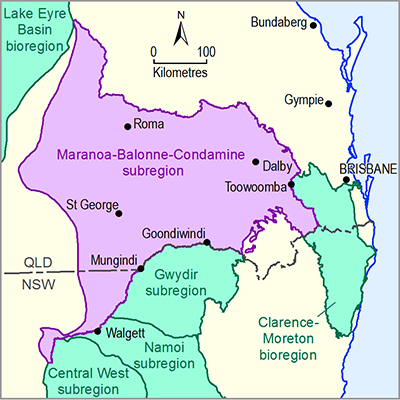The Maranoa-Balonne-Condamine subregion, in southern Queensland and western NSW, is based around the Border Rivers, Maranoa-Balonne and Condamine natural resource management regions and a small eastern portion of the South West Queensland natural resource management region. The Maranoa-Balonne-Condamine subregion covers an area of 144,890 km2. The subregion extends south towards the terminal lakes and wetlands of the Narran River (Figure 36). The major river basins of the Maranoa-Balonne-Condamine subregion are the Condamine-Balonne, Border Rivers and Moonie (Section 1.1.5). The dominant land use is agriculture based around a mixture of cropping and grazing (Figure 11).
The subregion spans the high country in the upper Condamine catchment and Border Rivers in the east to the wide alluvial western plains in the lower portions of the river basins (Figure 5). The topography contains three distinct landforms: the tablelands, slopes and plains. The north-eastern portion of the Maranoa-Balonne-Condamine subregion rises in the Great Dividing Range near Toowoomba at about 1400 mAHD within the Condamine river basin and falls to the lower Balonne floodplain wetland complex at about 200 mAHD. Similarly, the Border Rivers river basin comprises the tablelands in the east at about 1400 mAHD elevation, characterised by granite and basalt tablelands, grading into the slopes region characterised by undulating country with numerous permanent and semi-permanent billabongs. The plains region is downstream from the township of Boggabilla, where the terrain is undulating to flat. Floodplains stretch west towards Mungindi. The majority of river flows within the Maranoa-Balonne-Condamine subregion discharge either to the Barwon River south through NSW (via the Culgoa and Bokhara rivers) or toward the terminal lakes and wetlands of the Bokhara and Narran rivers (Figure 28).

